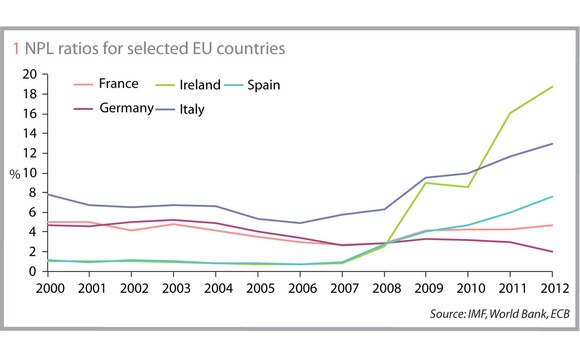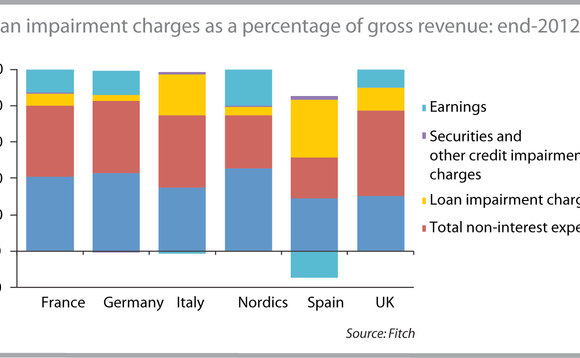
Can ECB draw a line under European banking fears?
Before the European Central Bank takes on its new supervisory role, a planned asset-quality review should ensure it is not walking into trouble. That’s if the process is thorough, of course, and untainted by political pressure – sceptics say that will be hard to pull off. By Tom Newton

No-one knows the extent of forbearance within Europe’s banking system. Restructuring loans to offer debtors temporary relief – by lowering interest payments, or extending the maturity – is a bilateral process, offered at the discretion of individual banks. In some cases, it may be quietly directed by supervisors keen to ease stress. Without financial statements, investors can only guess at how much of this is going on.
But there are clues. The relationship between non-performing loans (NPLs) and the health of the overall economy is one. In theory, as GDP falls or stagnates, the ratio of non-performing to performing assets should increase. True to form, this ratio has tracked up in Spain, Italy, Ireland and the UK in recent quarters, as growth remains stubbornly elusive. Where the relationship does not hold, alarm bells start ringing.
“The oddity is France, where NPL ratios have been stable despite two years of effectively zero growth. There’s a disconnect there between a reasonably good predictor of loan losses and what French banks are reporting,” says Nick Anderson, senior equity analyst at Berenberg Bank in London.

Forbearance during periods of financial stress is often seen as prudent. Far better to hold out for economic recovery and improving personal and corporate balance sheets than to force bankruptcy, liquidate collateral in a depressed market and risk exacerbating the crisis. But if growth doesn’t return, then debtors may never be in a position to pay and banks will have to take losses. With little sign of a European economic rebound, many are worried the industry’s balance sheets may be disguising a growing mountain of bad loans.
We believe very strongly there’s a lot of forbearance going on – it’s on a significant scale
“We believe very strongly there’s a lot of forbearance going on – it’s on a significant scale,” adds Anderson.
The European Central Bank (ECB) now has an opportunity to provide some certainty. Under Europe’s banking union proposals, published by the European Commission in September last year, the ECB is given the job of conducting a supervisory review – often referred to as an asset-quality review – to assess whether banks are making adequate provisions for their risks. If the ECB decides they are not, it is given the responsibility of imposing “specific additional own funds requirements, specific publication requirements, specific liquidity requirements and other measures”.
Details are scarce on how the review will work – and the ECB says it’s too early to comment – but it is easier to say what the review is for.
“Both the ECB and the creditor member states in Europe want to know what they’re getting themselves into. Legacy losses should continue to be the responsibility of member states. Going forward, once banks are under the direct supervision of the ECB, the door is potentially open to direct recapitalisation from the European Stability Mechanism,” says Thomas Huertas, a partner at Ernst & Young, and former alternate chair at the European Banking Authority (EBA) in London.
For a recent precedent, the ECB could look to Spain. The Banco de España (BdE)co-ordinated its own asset quality review and attendant stress tests on a selection of Spanish banks in mid-2012. It targeted the most dubious areas of Spanish balance sheets – credit risk exposures to the domestic private sector, representing around 36 million loans logged in the central bank’s database.
The Spanish review required an audit firm – not the bank’s usual auditor – to go through the books and assess the way the bank was classifying loans and its approach to restructuring. Auditors took samples of assets to verify the processes, between them poring over 16,400 individual loan assets in detail, with the aim of sanity-checking the banks’ loan loss estimates. Ultimately, it concluded that the country’s banking system needed an additional €24 billion in capital.

Few believe the ECB is envisaging this kind of forensic exercise. “We can only speculate, but I can’t see the ECB doing a deep-dive through particular names. It’s going to have to be principles-based and on a portfolio level,” says James Longsdon, co-head of Europe, Middle-East and Africa (EMEA) financial institutions at Fitch Ratings in London.
But there could still be important lessons for the ECB from the Spanish exercise. Critically, the review focused on revaluing portfolio losses on foreclosed assets, roping in six valuation firms to assess the true realisable value of portfolio held as collateral. As real-estate prices have collapsed in Spain, critics claim banks have been slow to mark down the value of property – including commercial property – used as collateral for their loans, especially for loans to real estate developers. So, the review of these assets helped resolve a big question mark.
“Prices will likely continue to decline in Spain – and banks will have to provision accordingly. That won’t be marginal, but it’s still a lot less than the amount already committed in the second half of last year. The real-estate exposures of Spanish banks’ balance sheets are now relatively clean,” says Alain Dupuis, portfolio manager for a European banking fund run by Oddo Asset Management, in Paris.
Investors want to see a similar focus from the ECB’s review. The hope is that it will help clear up confusion over the coverage ratio – the amount reserved against non-performing assets. Coverage ratios at French banks are around 70% on domestic retail exposures, but only around 35% in Italy, says Dupuis. That looks bad for Italian banks, but it may not tell the whole story.
“You can play around with this coverage rate. In the numerator you have the collateral. The key question is the value of that collateral – when you reduce the collateral, you’re mechanically reducing the coverage ratio,” adds Dupuis.
Ratios in Italy are lower because the Banca d’Italia has followed the Spanish example and is forcing banks to reappraise the value of collateral held on loans, including real estate. Accordingly, the latter half of 2012 saw a raft of Italian banks dramatically increase provisions. UniCredit booked €9.6 billion of provisions over the course of the year – up nearly 70% on 2011 – with almost half coming in the fourth quarter, according to its annual report.
And it’s not just property collateral that needs to be assessed. Lending to corporates is often collateralised with more esoteric assets – industrial machinery, for example. Cynics believe banks in Europe are blindly optimistic about the value of some of this collateral. Germany’s Norddeutsche Landesbank recently announced provisions against souring shipping loans had ballooned to €241 million, from €33 million a year earlier. It’s not an isolated problem.
“Problem legacy assets in the German banks are mostly foreign commercial real-estate loans, and also ship-financing portfolios. Every time they report, collateral values seem to go down and they’re reserving more against ship-financing portfolios,” says Bridget Gandy, co-head of EMEA financial institutions at Fitch Ratings in London.
Concerns over corporate lending, particularly to small and medium-sized enterprises (SMEs) don’t just revolve around the way collateral is being valued. There’s a widespread belief banks are optimistically continuing to mark these assets as performing, even when there’s little hope of recovering the full loan – influencing the denominator of the coverage ratio too.
This is one area where the Spanish review may have been less successful. The BdE tightened the requirements for loans which had been restructured, encouraging banks to categorise them as performing, sub-standard, or non-performing. No provisions are held against performing loans, 15% against sub-standard, and 45% against non-performing, according to Oddo’s Dupuis. It means provisions can jump considerably if a loan migrates from one bucket to the next.
“The treatment of restructured loans is the key issue in Spain. For some banks it’s up to 10% of their books, so it’s a huge amount of assets. Just a change in how they are categorised has massive implications for the level of provisions,” says Dupuis.
Currently, there is no standard European regime for the classification of non-performing loans, and these distinctions have a big knock-on effect on the level of provisions banks make. It’s an area the ECB is expected to focus on, as it tries to improve comparability among supervisory assessments in Europe.
In a speech in January, Vítor Constâncio, vice president of the ECB, alluded to how this might be done, saying the ECB and EBA would develop a manual of supervisory practices. He specifically highlighted provisioning as an area where a consistency of approach was needed. This work has since begun. On March 26, the EBA launched a consultation on common definitions of forbearance and non-performing exposures. The latter, according to the authority’s draft definition, are those where a material amount of total exposure to a counterparty – more than 20% – is overdue by 90 days or more. The document accepts forbearance is a more amorphous term, though, so the EBA gives it a less-concrete definition that looks to capture the essence of contract modification or restructuring.
The EBA will incorporate the two definitions in technical standards that will harmonise financial reporting of own funds for European bank capital requirement legislation. But the definitions won’t have legal force themselves – they do not supersede existing accounting and regulatory definitions. For example, they won’t be used when calculating risk weights for regulatory capital.
Instead, they’re being offered up as guidance, to help supervisors run asset-quality tests and banks harmonise their disclosures. There’s also not much time; the EBA expects to finalise these standards by the third quarter this year, so there’s unlikely to be anything other than a best-efforts attempt to enforce the definitions given the timetable the ECB requires.
And the ECB is facing a more fundamental problem, too. It’s assumed the ECB wants an accurate picture of the banking system it will supervise, but what if it doesn’t like what it finds?
Past efforts to force banks to open closets and parade their skeletons have been successful in restoring confidence, but only because supervisors were ready to force recapitalisation. Even before stress tests in the summer of 2009, the US forced its banks to accept capital. A crucial pillar of Japan’s effort to resolve the problems of its zombie banks was the willingness to recapitalise, including via nationalisation where necessary (see box).
This is missing in Europe. The region’s drive towards banking union will eventually see the creation of a recovery and resolution system, where banks may access financing from a single European fund with a fiscal backstop. But that will be too late to help if the ECB’s asset quality review uncovers significant hidden losses and capital shortfalls.
Those liabilities will remain squarely on the shoulders of national governments. Unless they are willing to pump more money into their banks, there are fears the ECB will shrink from the rigour and transparency the exercise demands.
“The review can assuage doubts and highlight areas where additional capital is needed. However, it doesn’t answer the question of where that additional capital might come from,” says Huertas at Ernst & Young.
BOX: The Takenaka plan
Japan’s asset price collapse in the mid-1990s left a legacy of non-performing assets that blighted the banking sector into the next decade. In autumn 2002, the country’s new finance minister, Heizo Takenaka, tried to stop the rot.
What’s now known as the Takenaka plan forced a series of measures on banks, including consistency in how they regarded loan quality and the screening of phantom deferred tax assets that they used to bolster their capital numbers.
“They also forced assessments to use discounted cashflows. So loans could no longer be marked as performing if debtors were making interest payments of one basis point with no realistic hope for improvement. At its core was honesty,” says Anil Kashyap, professor of economics and finance at the University of Chicago’s Booth School of Business.
Airing the books allowed investors to get to grips with the degree of forbearance in the Japanese banking sector. “Ten years ago in Japan, when you met investor relations at a bank, they’d hand you a six-inch book detailing every single loan, inviting you to flick through and see how they’d been treated,” says Nick Anderson, senior equity analyst at Berenberg Bank in London.
From a peak of ¥27.626 trillion ($273 billion) in March 2002, non-performing loans (NPLs) steadily declined after the Takenaka plan started later that year. The major banks disposed of about ¥7 trillion of NPLs each year from 2002 to 2005, says Kashyap. But transparency was only half the story. To shore up confidence, the plan also needed the backstop of public money.
“One of Takenaka’s main points was ‘be prepared to nationalise these guys if they don’t come up with the money’,” says Kashyap.
Only users who have a paid subscription or are part of a corporate subscription are able to print or copy content.
To access these options, along with all other subscription benefits, please contact info@risk.net or view our subscription options here: http://subscriptions.risk.net/subscribe
You are currently unable to print this content. Please contact info@risk.net to find out more.
You are currently unable to copy this content. Please contact info@risk.net to find out more.
Copyright Infopro Digital Limited. All rights reserved.
You may share this content using our article tools. Printing this content is for the sole use of the Authorised User (named subscriber), as outlined in our terms and conditions - https://www.infopro-insight.com/terms-conditions/insight-subscriptions/
If you would like to purchase additional rights please email info@risk.net
Copyright Infopro Digital Limited. All rights reserved.
You may share this content using our article tools. Copying this content is for the sole use of the Authorised User (named subscriber), as outlined in our terms and conditions - https://www.infopro-insight.com/terms-conditions/insight-subscriptions/
If you would like to purchase additional rights please email info@risk.net
More on Credit risk
Finding the investment management ‘one analytics view’
This paper outlines the benefits accruing to buy-side practitioners on the back of generating a single analytics view of their risk and performance metrics across funds, regions and asset classes
Revolutionising liquidity management: harnessing operational intelligence for real‑time insights and risk mitigation
Pierre Gaudin, head of business development at ActiveViam, explains the importance of fast, in-memory data analysis functions in allowing firms to consistently provide senior decision-makers with actionable insights
Sec-lending haircuts and indemnification pricing
A pricing method for borrowed securities that includes haircut and indemnification is introduced
XVAs and counterparty credit risk for energy markets: addressing the challenges and unravelling complexity
In this webinar, a panel of quantitative researchers and risk practitioners from banks, energy firms and a software vendor discuss practical challenges in the modelling and risk management of XVAs and CCR in the energy markets, and how to overcome them.
Credit risk & modelling – Special report 2021
This Risk special report provides an insight on the challenges facing banks in measuring and mitigating credit risk in the current environment, and the strategies they are deploying to adapt to a more stringent regulatory approach.
The wild world of credit models
The Covid-19 pandemic has induced a kind of schizophrenia in loan-loss models. When the pandemic hit, banks overprovisioned for credit losses on the assumption that the economy would head south. But when government stimulus packages put wads of cash in…
Driving greater value in credit risk and modelling
A forum of industry leaders discusses the challenges facing banks in measuring and mitigating credit risk in the current environment, and strategies to adapt to a more stringent regulatory framework in the future
Accelerating the evolution of credit decisioning and modelling
Anthony Mancuso, director, global head of risk modelling and decisioning at SAS, explains the importance of developing a fully capable credit modelling lifecycle to empower non-specialist personnel, and offers insight into its own solutions to this end,…







